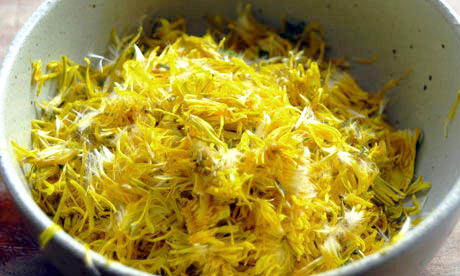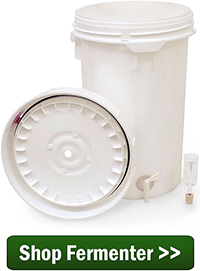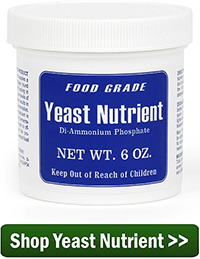 How about making some dandelion wine with the dandelion wine recipe below?
How about making some dandelion wine with the dandelion wine recipe below?
Most of the changes that spring brings are well received, like: warmth, sunshine, longer days, but there are a few changes that are not as welcomed. For most, the dreaded dandelion falls into this latter category. That’s why for some, making a bit of dandelion wine might strangely feel like a bit of revenge. Below is a dandelion wine recipe to help exact your revenge.
Dandelion wine is one of those traditional wines that has long served as a symbol of country winemaking – that classic wine creation that comes from the little ol’ winemaker everybody knows. Even though dandelion wine has a deep-rooted past in American culture, there are plenty of home winemakers still making it today and enjoying every bit of it.
So, what does dandelion wine taste like, you ask? This dandelion wine recipe makes a light-bodied wine with a beautiful yellow color. It’s flavors are herbal and muddled with an incredible bouquet that is bright and full of herbs and flowers.
The trick to making a good dandelion wine is to use the dandelion petals, only. Stay away from any of the green. The greens will add a vegetable-like character to the wine that will seem foreign and out of place.
Spring is the perfect time to make some dandelion wine, so here’s a 5 gallon dandelion wine recipe to get you going. It’s not that different from other country wine recipes. The types of ingredients are basically the same. A double-shot of nutrient is needed to make up for the lack of nutrients that you would normal get when making a wine from fruit. Plenty of acid blend is need as well for the same reason. Dandelions are not high in nutrients or acid.
You can vary the amount of dandelion petals quite a bit without affecting the rest of the dandelion wine recipe, but as a warning, adding to many petals could give you a wine the has a very hard time aging out into something you’d really want to drink. More petals is not necessarily better. While the wine recipe asks for 6 quarts, you could reasonably go up to 10 quarts.

Dandelion Wine Recipe
(Makes 5 Gallons)
- 6 qts. Dandelion Petals
- 11 lbs. Cane Sugar
- 1 tbsp. Yeast Nutrient
- 2 tsp. Yeast Energizer
- 3 tbsp. Acid Blend
- 1/2 tsp. Wine Tannin
- 1 pkt. Wine Yeast (Lalvin: K1V-1116)
- 10 Campden Tablets (5 before fermentation / 5 at bottling)
Making this dandelion wine is pretty straight-forward. You will want to be sure that the dandelions are herbicide and pesticide free. For this reason it is best to  pick them from an area you are familiar with. Once you have petals together, you will want to wash them in cold water – remove any ants or other insects – then blanch them by pouring boiling water over them and letting them steep in the water for 5 minutes. Don’t use any more boiling water then necessary. Be sure to use all the water from the blanching in the dandelion wine recipe, itself, as part of the 5 gallons.
pick them from an area you are familiar with. Once you have petals together, you will want to wash them in cold water – remove any ants or other insects – then blanch them by pouring boiling water over them and letting them steep in the water for 5 minutes. Don’t use any more boiling water then necessary. Be sure to use all the water from the blanching in the dandelion wine recipe, itself, as part of the 5 gallons.
Once you’ve gotten this far you can use the 7 Easy Steps To Making Wine as the instructions for making this dandelion wine recipe.
Anyone else have a dandelion wine recipe they’d like to share? Just leave it in the comments below!
—–
Ed Kraus is a 3rd generation home brewer/winemaker and has been an owner of E. C. Kraus since 1999. He has been helping individuals make better wine and beer for over 25 years.

How do you figure out what 6 quarts are? The flowers are a dry product and you’re using a liquid measure. Is there a way to convert it to pounds?
Kate, I understand your concern. I do not have a weight, however you just want to lightly pack the petals to get 6 quarts.
When you speak of petals are you referring to the yellow flower only? In particular should one be removing even that little bit of greenery that is directly below the blossom.
John, you can get away with a little bit of green, but you really want to try hard to use only the yellow.
Dandelion Wine- (Very old recipe)
10 to 12 oz of Dandelions (the whole head greens and all) per gallon Clean and chemical free
2 1/2 to 3 lbs sugar per gallon
1 Orange and 1 Lemon washed and sliced squeeze in juice and add fruit, per gallon
1 cup golden raisins per gallon
1 cup of dark rasins
1 cup very strong Tea, tannin
Yeast Nutrient, per gallon as listed on instructions
Yeast Energizer (Gostex is very good)
Acid Blend
1 campten tablet per gallon
Wine Yeast, Champagne
Wine Stabilizer and Clairifier as needed.
Water as needed for batch size
Boil flowers for 1/2 hour maintain water level then strain and discard flowers. add all other ingredients except the yeast, clairifier and stabilizer allow to cool to room temp 56 to 64 degrees Fahrenheit. Place in vessel with bubbler and adjust for batch size liquid. Take small amount of warm water and sugar to start the yeast add after yeast is activated. Once the batch is working hard make sure to press down the fruit cap and stir. do this every day for 2 to 3 weeks depending on activity. then siphon and strain into secondary fermenter in 6 to 8 weeks siphon off again and add Spakaloid fining agent. put back in secondary fermenter and allow to clear 2 weeks. Siphon off and adjust sugar to 1.010 to 1.020 SG for a nice dessert wine. Now add correct amount Wine Stabilizer for your batch size age 3 to 4 months and enjoy. This wine will keep for 1 year if you can keep out of it!
I have used this recipe since the early Seventies I learned it from a gentleman that started making it in the Forties.
HI I HAVE DONE A SIMILAR REC…..WAS TOLD BY OLD POLISH LADY WILL STORE FOR YEARS AND GET STRONGER.
and the green doesn’t make it bitter?? I know when I make dandelion to eat you just keep boiling until the bitterness is gone. Thanks for the recipe.
If I wanted to go the Meade route, what would be the converted amount of honey to use in place of the cane sugar?
Thanks
Doug, the conversion is right around 1 to 1.33. So for every pound of cane sugar called for exchange it with 1.33 pounds of honey.
How much blanching water do I need?
Frank, there is not specific amount needed. You just want to use enough to come in contact with all the petals, so it would depend, some, in the profile of the container they are in. The goal is two-fold: you are trying to brew a tea with it, but more importantly, you are sanitizing it — destroying all the wild molds an bacteria that is on the flowers.
I use 25 cups of flowers or a little more, plus 4 pounds white raisins chopped. I wait at least one day to remove the flowers from their green casing. I put the flower between my thumb and index finger and give a twist which pops the flower away from the green casing. As a side note, I put the must into its first carboy this past Sunday and put the dregs into the compost. Our new young dog ate the dregs and stumbled around the rest of the day. This wine is a lot of work but well worth the effort.
6 quarts of loose packed pedals.
32 cups of sugar
1.25 cups of lemon juice (organic)
1.25 cups of orange juice (organic)
2 quarts of white grape juice (organic)
4.25 tsp yeast nutrient
1.25 tsp wine tannin
6 Campden tablets
3 tsp pectic enzyme
1 packet Lavlin EC-1118 yeast
Freeze the Pedals for 1 year (turned out way better than using fresh). Put frozen petals in a bag and slowly bring to a boil. Boil rapidly for 1/2 hour mashing every 5 minutes. Put the bag and water into the fermentation bucket. Heat 16 cups of sugar in a half gallon of water 2 times and add to the mash. Fill with water until the gravity reaches 1.104. Add ingredients when the mash drops under 80 degrees. Add yeast after 24 hours.
I use this same recipe for rhubarb (14.5 lbs of small cubes juiced and not boiled, 3.25 tsp of acid blend instead of Orange and Lemon juice) and it works great. However the Dandy Lion, is always the center piece of any party (I have to bottle it in 1 gallon jugs as it goes that quickly). Can really taste the flower! Dandelion needs to be racked once a month for 8 months to clear before bottling. The batches I bottled early dropped sediment in the bottle even after adding sulphites at bottling time. I allow my fermentation die naturally, It is a little more dry, but the fruit/flower flavor seems to be better, usually dies around .092-.096. You can back sweeten with pectin sugars if wanted, but I found it takes from the natural flavor of the flower. Rhubarb clears in 2 months and is ready to drink 1-2 months after bottling. Dandelion was just OK after 6 months, but really matured after a year and still remains among best I’ve made competing with purple mulberry (lots of bugs to deal with in Mulberry). I tried combining Rhubarb and Dandelion, but the Rhubarb flavor trumped the flower. Using the white grape juice in my gallon testers taste almost the same as the natural Dandelion but really smoothed the flavor after a year vs just natural flower. All other fruits I tried on my testers stole from the Dandelion flavor and rendered all the picking a waste of time. DON’T get any greens in the petals! I tried several batches using the heads instead of petals and all were bitter….I like the tea mentioned in a previous recipe. I may have to do some tests using light teas.
How much does this make? Do you add water?
this recipe is similar to others, I tweak it to the amount of Dandelions
I pick. 26 cups Blossom
3 1/2 gal boiling water
3/4 tsp energizer
4 campden tablets
3/4 tsp tannin powder
12 tsp Acid blend
15 oz white raisins
pour boiling water over blossoms in must bag, let sit and cool ,add champagne yeast .aft a few days I take must bag out. racked till Sg was 1.03 and bottled. this recipe took a blue ribbon, and 2nd best of show ,over a 100 entry’s.
I forgot the sugar. I put sugar to Sfg of 1.085
Hey Ed, I have been making wine for many years and have had some failures and many successes, Dandelion wine intrigued me. I live in Western NC and the dandelions are free. I harvested a passel of them and did al the steps. My question is when I open the 1st bottle? I keep my wines in a wine cooler at 55F. I plan on opening the 1st bottle after three months. Do you agree?